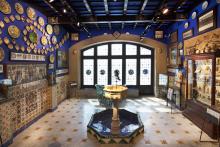Rusiñol Collection
The mania of owning and collecting antiquities is an incurable disease"
Santiago Rusiñol, My old irons (1893)
"Collectors of Antiques are junkmen of memories"
Santiago Rusiñol, Maxims and evil thoughts (1927)
Art, collectionism and hiking became the three subjects in which converged the artistic interest of Santiago Rusiñol, furthering the polyhedral figure of the artist, intellectual, scientific hiker, journalist, archaeologist, writer and collector. Rusiñol started as a collector in the workshop of his first teacher, the painter Tomàs Moragas, friend and follower of Marià Fortuny. Scientific hiking, in which Rusiñol regularly and enthusiastically participated during the eighties, was another area in which Rusiñol developed his activities as collector. Collectionism became the first public projection of the artist and the profile that, along with his dedication to the cult of art, was what defined him more precisely. Collectionism became one of the most characteristic profiles in the total personality of the artist to the end of his days. Each of the works in the museum is directly related to a passage in the life of the artist. The Cau Ferrat Museum, in addition to showing a splendid collection of ancient and modern art, is the "collection of the heart" of the artist.
The formation of the art collection of Rusiñol corresponds to three stages. The first, the most prolonged one, begins in 1875 and culminates with the lecture given at the Barcelona Athenaeum (Ateneu Barcelonès) in 1893, “Mis hierros viejos” (My old irons). The lecture is related mainly to the formation of the wrought iron collection, and to the pieces of ancient art, that were kept by then at the workshop that he shared with sculptor Enric Clarasó in Barcelona called Cau Ferrat.The collection of wrought iron. Wrought iron objects pices and different religious or profane objects that became obsolete or were part of the large number of ancient and anonymous works, the result of the constructive and artistic effort of ancient craftsmen, were the subject of attention by some of hikers at the time, expressed as illustrations of the various newsletters and publications for hikers during the seventies and eighties of the nineteenth century.
The second stage occurs in Cau Ferrat in Sitges. It begins with the purchase of paintings by El Greco in Paris in January 1894, Tears of Saint Peter and the Penitent Magdalene, and closed in 1902 with the acquisition of the collection of glass from Alexandre de Riquer with the Installation of the painting Holy Thursday in Pollença (1902), the latest work of Rusiñol entering the Cau Ferrat in Sitges.These are the years of the Festes Modernistes (1892-1899) culminating in 1898 with the inauguration of the monument to Greco, the golden decade of the artist in Sitges. During this stage he enters Cau Ferrat with the will of giving shape to the colection of the artist, most are paintings of Rusiñol and his friends such as Ramon Casas, M. T. Müller, Enric Clarasó Arcadi Mas i Fondevila, Ramon Pichot, Zuloaga, Regoyos, and that the purchase of young emerging talents: Isidro Nonell, Picasso and Manolo Hugué, who frequents "el 4 Gats". Cau Ferrat assimilated a large number of art works and artistic objects from his travels and artistic campaigns: Montmartre and Paris, Italy (copies made by Rusiñol of frescoes and paintings of old painters); Andalusia (oils and drawings in Granada and Víznar); copies made by him and others (Ramon Pichot or Pere Ferran) in the Museo del Prado, etc. Objects like the Japanese folding screen or the piano in his studio, used by Manuel de Falla to compose the suite Nights in the Gardens of Spain in 1916. All such objects grant to Cau Ferrat a very specific look and a unique and unrepeatable ambience.
The third stage corresponds to the first third of the twentieth century, when the change of life of Rusiñol after his morphine detox treatment involves a new routine and habits, almost always accompanied by his wife and daughter - both included in works in the walls of the museum. Worth of mentioning are the entrance to the collection of the pre-Roman and Punic archaeological collection coming from excavations at the Puig des Molins (Ibiza) and the sketches of Ramon Casas with couplets from Gabriel Alomar for "L'Auca del senyor Esteve" (The Auca of Mr. Stephen) (1907 ).Several pieces of pottery come from his trips and campaigns to Andalusia, Mallorca, Valencia and Castile. El Cau Ferrat ceases to be a home workshop and his owner arrives to the point of giving cards authorize visits during his absence.
As an epilogue, the last stage of the Cau Ferrat begins with its reopening as public museum (1933). Santiago Rusiñol bequeathed his property to the town of Sitges taken by the love he felt for the town, as established in his will. Without betraying or modifying the structure or areas, Joaquim Folch i Torres, director of the Museum of Art of Catalonia and the first director of the Museum of Cau Ferrat with his team carried out works, inventory, classification and relocation of works. It is the stage in which "Modernisme" became a museum. In 1935, arrives el "Penel de gall" (Weathercock) from sculptor Pablo Gargallo, donated by his widow to be added to the wrought iron collection.
Cau Ferrat became a symbol of the cultural history of the country


 Buy tickets
Buy tickets Buy tickets
Buy tickets









